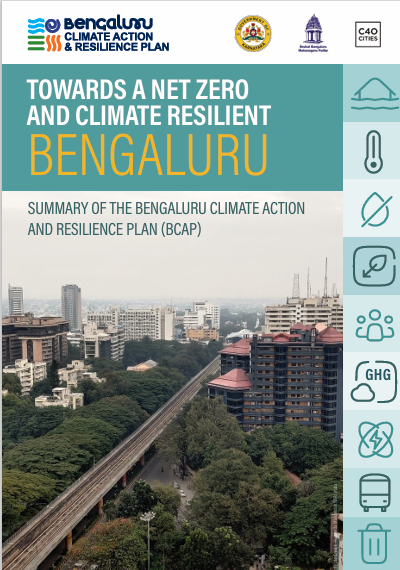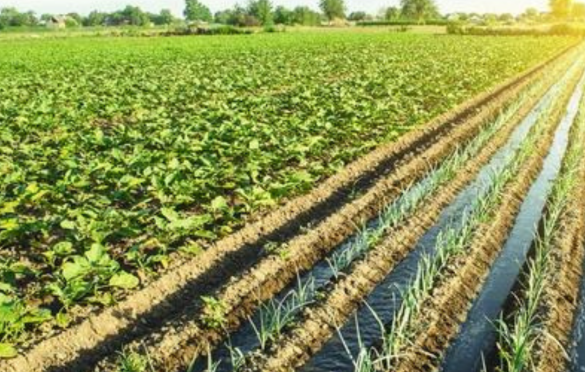The Bruhat Bengaluru Mahanagara Palike (BBMP) in Nov 2023, launched the Bengaluru Climate Action and Resilience Plan (BCAP) with an eye towards achieving net-zero by 2050. As part of Bengaluru’s commitment to the C40 Cities initiative, the city is developing a data-driven, inclusive, and collaborative climate action plan. This plan, created in partnership with WRI India as the knowledge partner, aims to reduce greenhouse gas (GHG) emissions and foster healthy, equitable, and resilient communities.
Here is my attempt to summarize the findings of the report, in key data points & Question/Answer format.
Summary of Bengaluru Climate Action and Resilience Plan
Goals: Align with India’s climate commitments and enhance urban resilience.
Flood Risk Zones: 6% (High), 4% (Medium), 11% (Low) of city population affected.
Temperature Rise: Mean air temperature increased by 0.23°C per decade since 1975.
Heat Waves: Average of 60 extreme heat days per year; significant events in 2014-2015.
GHG Emissions: Focus on decarbonization, cleaner fuels, and public transport.
Monitoring: GHG inventory updated every 2 years; climate risk assessments every 3-5 years.
What are the key findings from the Bengaluru climate/environmental hazard assessment?
Key Findings from Bengaluru Climate/Environmental Hazard Assessment
- Bengaluru Urban District experienced an average of 282 heavy and 14 very heavy rainfall events per year from 2016 to 2021, contributing to 11% of total annual rainfall.
- A total of 1,167 flood events were reported between 2013 and 2020, identifying 372 flood vulnerable areas in the city.
- Flood risk zones are categorized as high, medium, and low, affecting approximately 6% and 4% of the population in high and medium-risk zones, respectively.
What specific actions are being taken to mitigate the impact of climate change in Bengaluru?
Specific Actions for Climate Change Mitigation in Bengaluru
- Bengaluru Climate Action and Resilience Plan (BCAP): A comprehensive roadmap focusing on greenhouse gas (GHG) mitigation and climate adaptation, aiming for net zero emissions by 2050.
- Multi-Stakeholder Collaboration: Engaging various government departments, civil society, and private sectors to ensure coordinated efforts in implementing climate actions.
- Data-Driven Approach: Regular updates of GHG inventories and climate risk assessments to inform policies and track progress towards achieving set targets.
What strategies are being implemented in Bengaluru to mitigate climate change effects? - Strategies Implemented in Bengaluru to Mitigate Climate Change Effects
- GHG Emission Reduction Targets: Setting ambitious goals of 16% reduction by 2030, 26% by 2040, and 56% by 2050, with a long-term aim for net zero by 2050.
- Sectoral Focus: Addressing key sectors such as energy, transport, waste management, water, air quality, urban planning, and biodiversity to create a comprehensive climate action framework.
- Community Engagement and Consensus Building: Involving citizens and stakeholders in discussions to foster ownership and ensure that climate actions are inclusive and equitable.
What are the key findings from the Bengaluru climate/environmental hazard assessment? - Key Findings from Bengaluru Climate/Environmental Hazard Assessment
- Rainfall Events: The city experienced an average of 282 heavy and 14 very heavy rainfall events annually from 2016 to 2021, accounting for 11% of total annual rainfall.
- Flood Vulnerability: A total of 1,167 flood events were reported between 2013 and 2020, leading to the identification of 372 flood vulnerable areas in Bengaluru.
- Flood Risk Zones: The population is categorized into high (6%), medium (4%), and low-risk zones based on flood vulnerability, indicating significant exposure to flooding hazards.
What specific actions are being taken to improve public transport in Bengaluru? - Specific Actions to Improve Public Transport in Bengaluru
- Multimodal Integration: Enhancing connectivity between different modes of transport to improve public transport ridership and reduce reliance on private vehicles.
- Transit-Oriented Development (TOD): Ensuring that 92% of new households are located in Transit Oriented Development Areas by 2050 to promote accessibility and reduce travel distances.
- Public Transport Share Goals: Aiming for a combined share of public transport and non-motorised transport to reach 75% of total trips by 2030, increasing to 85% by 2050.
What specific actions are being taken to mitigate flood risks in Bengaluru?
Specific Actions to Mitigate Flood Risks in Bengaluru - Flood Vulnerable Area Identification: Mapping and identifying 372 flood vulnerable areas to prioritize interventions and enhance preparedness.
- Integrated Urban Water Management: Implementing an approach that includes freshwater, wastewater, and stormwater systems to improve drainage and reduce flooding.
- Green Infrastructure: Restoring and enhancing sponge spaces to increase groundwater recharge and decrease stormwater runoff, aiming for 40% of the city’s surface area to be permeable by 2040.
What are the key challenges faced by Bengaluru’s public transport system?
Key Challenges Faced by Bengaluru’s Public Transport System - High Dependency on Private Vehicles: A significant reliance on private transportation leads to congestion, increased emissions, and reduced public transport ridership.
- Inadequate Infrastructure: Insufficient public transport infrastructure and facilities hinder effective multimodal integration and accessibility for users.
- Funding and Investment Constraints: Limited financial resources and investment in public transport projects affect the expansion and improvement of services, impacting overall efficiency and reliability.
Long-Term Goals of the Bengaluru Climate Action and Resilience Plan - Net Zero Emissions by 2050: Achieving net zero greenhouse gas emissions to align with global climate commitments.
- Significant GHG Reduction Targets: Aiming for a 34% reduction by 2030, 58% by 2040, and 91% by 2050 to mitigate climate change impacts.
- Enhanced Climate Resilience: Building adaptive capacity in the city’s infrastructure, economy, and communities to withstand and recover from climate-related hazards.
What specific actions are being taken to achieve the net zero emissions goal by 2050 in Bengaluru?
Specific Actions to Achieve Net Zero Emissions Goal by 2050 in Bengaluru - Decarbonization of the Electricity Grid: Transitioning to non-fossil fuel sources, targeting 68% by 2030 and 89% by 2050 in the city’s electricity generation mix.
- Energy Efficiency Improvements: Promoting energy-efficient appliances and green building practices, with goals for 40% of new appliances to be high-efficiency by 2030.
- Sustainable Transportation Initiatives: Increasing the share of public transport and non-motorised transport to 75% of total trips by 2030, while promoting cleaner fuels and reducing travel distances through urban planning.
What specific actions are outlined in the Bengaluru Climate Action and Resilience Plan to achieve its long-term goals?
Specific Actions Outlined in the Bengaluru Climate Action and Resilience Plan - Urban Planning and Greening: Implementing climate-aware urban planning, promoting compact development, and adopting Nature-Based Solutions to enhance resilience and livability.
- Energy and Buildings: Encouraging energy efficiency, transitioning to renewable energy sources, and setting targets for high-efficiency appliances in new constructions.
- Transport and Mobility: Enhancing public transport infrastructure, promoting non-motorised transport, and integrating multimodal transport systems to reduce emissions from the transport sector.
What are the key challenges Bengaluru faces in achieving its climate action goals?
Key Challenges Bengaluru Faces in Achieving Climate Action Goals - Rapid Urbanization: Managing the pressures of rapid urban growth, which complicates infrastructure development and resource management.
- Funding and Investment: Securing adequate financial resources and investment for implementing climate action initiatives and infrastructure improvements.
- Coordination Among Stakeholders: Ensuring effective collaboration and coherence among various government departments, civil society, and private sector stakeholders to achieve collective climate goals.
How can residents contribute to the goals outlined in the Bengaluru Climate Action and Resilience Plan?
How Residents Can Contribute to the Bengaluru Climate Action and Resilience Plan Goals - Adopting Sustainable Practices: Residents can reduce energy consumption, use public transport, and practice waste segregation and recycling to minimize their carbon footprint.
- Participating in Community Initiatives: Engaging in local climate action programs, tree planting drives, and community clean-up efforts to enhance urban greening and biodiversity.
- Advocating for Climate Awareness: Raising awareness about climate issues within their communities and supporting policies that promote sustainability and resilience in urban planning.
What are the projected impacts of climate change on Bengaluru’s urban infrastructure?
Projected Impacts of Climate Change on Bengaluru’s Urban Infrastructure - Increased Flooding: More frequent and intense rainfall events are expected to overwhelm drainage systems, leading to urban flooding and infrastructure damage.
- Heat Stress on Infrastructure: Rising temperatures can exacerbate heat-related stress on buildings and roads, increasing maintenance costs and reducing lifespan.
- Water Scarcity: Changes in rainfall patterns and increased evaporation rates may lead to water shortages, impacting water supply systems and overall urban resilience.



Leave a Reply